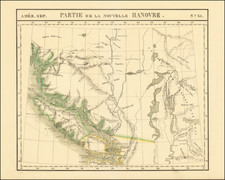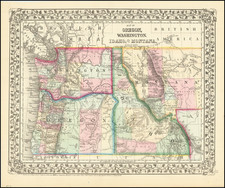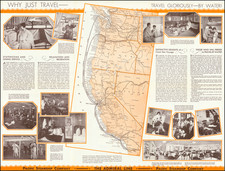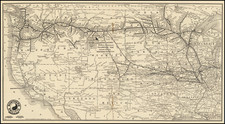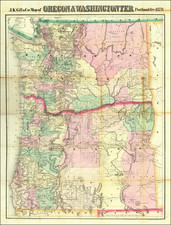The First Map of Everett, Washington. A Western Town Plan Masterpiece.
Extremely rare and impressive plat map of Everett, Washington. This work is the first traced map of Everett, published one year before its incorporation, and a fantastic look at the nascent settlement.
The historically significant lumber town of Everett was conceived of in 1890 when the lumberman Henry Hewitt and railroad executive Charles L. Colby decided to found an industrial town at a site thought to be the most likely terminus for the Great Northern Railway. This map was produced less than two years after that initial conception and only one year after the town gained its first businesses.
The map is remarkably attractive and emblematic of the best Western map design from the late 19th century. It shows downtown Everett between 22nd and 33rd street, centered on Hewitt Avenue and the Snohomish, Skomihs & Spokane (Three S) Railroad, which had then run out of money after laying just under five miles of tracks. The map is colored according to landholders, with the Everett Land Co's holdings in yellow, Rucker Brothers holdings in pink, and lands reserved for sale in white. Individual lot numbers are shown.
The design of the insets, presented in a trompe l'oeil form of sketched wall maps or roll maps, each with its own title, is exemplary of the late-19th-century style of Western land advertisement maps. These include three maps, one showing all of western Washington, one showing Snohomish County, and one showing the Everett Peninsula with additional platted areas not shown on the main map. A birdseye view shows Everett. Three local buildings, built and proposed, are shown including the steelworks, lumber mill, and hotel.
In all, a remarkable western plat map with important primacy.
Early History of Everett
This map is a snapshot of Everett at the earliest time in its history. The city was only conceived of, as aforementioned, in 1890 during an Alaskan Inside Passage cruise. The nearing completion of the Northern Pacific railroad enticed speculators that they could encourage it to terminate, or at least stop, in Everett, leading it to become the "Pittsburg of the West."
The early plans for the city enticed John D. Rockefeller to invest $800,000 in the project. The Rucker Brothers and Everett Land Company began to sell land, and businesses arrived in 1891. The city would ride high through the making of this map in 1892 until 1893, when it was incorporated.
As with much of the northwest, Everett was hit extremely hard by the Panic of 1893 and the decision to run the Great Northern Railway to Seattle. Despite this, the city managed to grow over the intervening years, and it was established as one of the most important lumber towns in the American northwest.
The 20th century brought labor unrest and the city's most infamous moment, the Bloody Sunday massacre of 1916. The arrival of IWW members by boat from Seattle led to a gunfight with anti-union authorities; such violence was characteristic of early anti-labor sentiment in the American West.
Primacy
We locate no earlier maps of Everett. Searches in OCLC with the term "Everett map" or "Everett plat" yield no earlier maps of the Washington city. Investigation of local resources, such as the Historic Everett map collection, reveals no other possibilities for an earlier map. The Sanborn Fire Insurance company also produced printed maps of Everett in May of 1892, but these are small-format maps of specific neighborhoods. This map was succeeded in 1893 by an equally rare bird's-eye view of the nascent town.
Rarity
We locate two examples of this map, at the University of Washington and at Washington State University.











